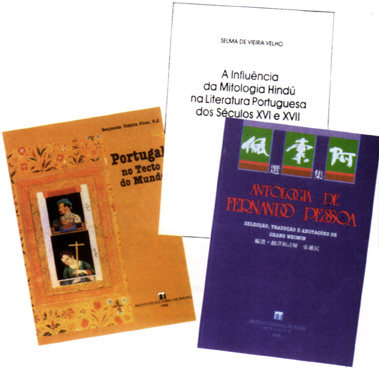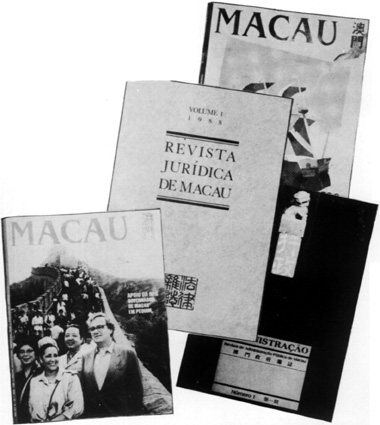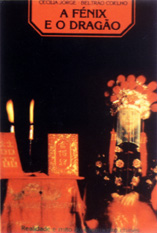The celebrations of Portugal, Camões and the Portuguese Communities Day, and the first centenary of Fernando Pessoa's birth led the Publishing Department of the Cultural Institute to publish some suitably relevant books during this quarter. The first appeared on the day when Portugal paid its respects to the author of Os Lusíadas and the second came out three days later on the centenary of the author of Mensagem. Before looking at Camões and Pessoa, however, I shall take a look at a book which was printed earlier in the quarter by a researcher who specializes in the history of Portugal and Macau.
I shall also look at a special edition of RC, the latest book to be published by the Historical Archives of Macau and various other publications which have appeared over the quarter. Finally, I shall end the review by examining the first in an interesting series on Chinese traditions and customs.
ICM PUBLICATIONS
Portugal no Tecto do Mundo (Portugal on the Roof of the World) is the result of bringing together documents and information now scattered all over the world. Issues of considerable historical importance are discussed and the conclusions at which the author arrives are of unmistakable historical value.
In his foreword, the author recalls Fernando Pessoa's words from Mensagem: "Deus quer, o homem sonha, a obra nasce". We should look to the author's own words in order to appreciate the content of this publication: "In this book, I shall use historical documentation to tell the story of two of the most remarkable undertakings in Portuguese Missionary History: the discovery of Tibet by Father António de Andrade, S. J., and the journey from Goa to Su-chow in the North of China by Brother Bento de Góis, also a Jesuit".
The author has done extensive research for this study and concludes that "Portugal was the first European country to set foot on the highest reaches of the globe, namely the "Roof of the World".
In 1983, Maria Selma de Vieira Velho, from Goa, presented A Influência da Mitológia Hindú na Literatura Portuguesa dos Séculos XVI e XII (The Influence of Hindu Mythology on XVIth and XVIIth Century Portuguese Literature) as her doctoral thesis in the University of Bombay.
Her work is "entirely based on Portuguese documentation" there being a total lack of Indian documentation for which the authoress blames "the neglect wreaked by time and men". She does, however, make liberal use of works by writers including Father Jacobo Fenício, D. Francisco de Garcia, Gil Vicente, Camões, Garcia de Horta, Fernão Álvares do Oriente and Rodrigues Lobo.

Vieira Velho begins her study with an examination of exchange between Portugal and India, presenting a general account of the development of Indian influence on Portuguese Literature. She uses this as the starting point for an interesting explanation of Hindu philosophy and myths.
She goes on to look at Hindu texts which were translated into Portuguese during the XVIth and XVIIth centuries with particular reference to the first European translation of the Ramayana, and there are several important examples of instances in which Indian myths may have influenced the literature of the period.
After discussing the repercussions of Indian culture on Portugal, the authoress examines the early symptoms of what she describes as "the suffocation of exchange between Portugal and India", analysing possible examples of the decline of this influence throughout the XVIIIth and XIXth centuries.
It is worth noting that it was in the forty years following Vasco da Gama's voyage that there was greatest Indian influence on Portuguese literature.
This is an important contribution to the history of the Portuguese in the East, and to the preservation of Portuguese links with India. Vieira Velho's study is indisputably a serious historical analysis of the dissemination of Indian culture over the world and the first steps in exchange between East and West as well as being an examination of what heritage remains in Goa.
To cater to the needs of Chinese readers, Antologia de Fernando Pessoa (Anthology of Fernando Pessoa's Work), a bilingual edition (Chinese and Portuguese) of Pessoa's poetry, has been published. The copious annotations which complement Zhang Weimin's selection are necessary to an understanding and awareness of Pessoa's message: O poeta é fingidor, Finge tão completamente Que chega a fingir que é dor A dor que deveras sente.
Regarded by some as the only Portuguese poet of the same stature as Camões, Pessoa himself appears on these pages beside Alberto Caeiro, Ricardo Reis and Álvaro de Campos, some of the most important heteronyms. Included in the anthology are poems and prose divided into chapters such as Quadras ao Gosto Popular, Páginas de Doutrina Estética and Fragmentos do "Livro de Desassossego", a representative selection of an extensive output which has been translated and admired in several languages. Produced in the Orient for the use of the Orient, this is yet another contribution to Pessoa's world-wide acclaim.
The month of June saw the publication of a special edition of RC in Portuguese.
Dedicated to the memory of the Portuguese presence in India, RC/ Índia (Special Edition) was produced in commemoration of Portugual Day, Camões Day and the Portuguese Communities Day on June 10th, 1988. Articles were contributed by various people interested in collecting and preserving information concerning Portugal's historical role in India, particularly in Goa, Damão and Diu, and moving out from there to other geographical areas which still have traces of a Portuguese presence.
The hundred-page magazine describes the different connections between Goa and Macau, Lisbon, Camões, Pessoa, Chaúl and Xavier through a collection of historical and sociological studies which speak for themselves.
At the close of the quarter, another volume of the Arquivos de Macau (Macau Archives) corresponding to 1986 came off the press. This edition is a follow-up to an earlier one containing an inventory of the Civil Service Records from 1921 to 1926.

OTHER PUBLICATIONS
In the second quarter of this year, Administração (Administration) came out dealing with issues concerning the local Public Administration with a section on "Legal Consultancy". It is a bilingual publication (Portuguese and Chinese) with an appendix in English containing abstracts of the articles. Of particular interest in this inaugural issue were a selection of papers presented in a Seminar organized by the Government's Public Administration Department last year called "The Role of Town Councils in the Life of the Territory". Administração is produced by a team headed by Guilherme Valente with cover design by António Conceição Júnior. There will be four issues a year and it has come out at a time when the new linguistic policy to be used in Macau is taking shape. It is a welcome newcomer, particularly because it will be a forum for useful debate during the Territory's transition period.
Yet another magazine to come to light in the second quarter was Revista Jurídica de Macau (Legal Review of Macau). In addition to a variety of articles, there is a section on reports and another one on jurisprudence with a final section of abstracts in Portuguese, Chinese and English. It should be noted that this new publication, the work of the Government's Legal Affairs Department, coordinated by Dr. João Miguel Barros with cover and graphic design by Victor Marreiros, has arrived at a particularly important time when all efforts are being made to guarantee the continuity of the laws in force and the legislative autonomy of the future Special Administrative Region of Macau, with the respective localization of the legal system and the adaptation of the law to present day needs. Revista Jurídica de Macau thus has a very welcome role in divulging the issues which are developing in an area of extreme importance to the future life of the territory.
The second quarter of the year also saw the publication of N°9 and N°10 of Macau, a monthly publication from the Government Media Department. N° 9 (Feb/Mar) has a cover celebrating "500 Years of Discoveries" with an illustration by Victor Marreiros. There is an article on the passing of sixty three years since Sun Yat Sen's death and an exhibition of Mio Pang Fei's work with an interview with the painter himself. There are also articles on the Portuguese in Japan, the role of the organization Fundação Macau, the work of the Missionaries of Charity in the territory and the departure of the Macau/Lisbon Overland Expedition.
N°10 (April) features the Governor's visit to Peking on the front cover and contains special articles on the policies governing the teaching of Chinese to Portuguese, the history of the Catholic Church in Macau, Chinese opera and a report on the Macau/Lisbon Overland Expedition, due to reach its destination on June 5th. As usual, this edition includes a good variety of interesting subjects from Art to History, Religion to Environmental topics and many others.

FACT OR FICTION: MARRIAGE OR CONCUBINAGE
After the declaration of the People's Republic of China in 1949, and the Cultural Revolution which followed, the age-old traditions of the Middle Kingdom were gradually destroyed. The goal was to bring them out from behind the mysterious veil behind which they had always hidden, examine them with a new, cold determination and then let them be buried by a nation which was trying to win back the real time which it had lost during its mythological past.
And so the verdict was passed: the marriage between fact and fiction would no longer be recognised. It would be regarded in the same light as any relationship condemned by the civilized concepts of modern life and(western) reasoning, as a kind of concubinage.
Are we not, however accustomed to seeing stories and legends as intimately connected? Do we not perceive ourselves through the tangential meeting between imagination and creation, and the facts of historical documentation? Didn't they teach us about life, when we were children, by using "stories about the time when the animals could speak"?
The link between fact and fiction must thus be everlasting and universal. It is a link which is kept by each culture in its own way. It is just as permanent in China although it has been cast aside and is now maintained in Hongkong and Macau. Particularly in Macau where it is kept with the care found in places where successive generations live out a quiet existence. The West still examines this vast China in a constant attempt to lift a corner of the veil which is draped over the permanent mysteries of an Orient which can never be completely understood.
Nowadays, the need for greater understanding leads the West in a desire to understand the Orient. And Macau is here to tell the tale with four centuries of wisdom, four centuries of understanding already behind it. Macau, a melting pot between two worlds, where the Portuguese have gathered together elements of this cultural transformation in which they have played a pioneering role, and taken them back to an Old Europe.
It is exactly in this period of gathering information that several projects have been undertaken, some of them specially designed to be included in the movement from Macau to Lisbon. It was with this in mind that ICM's Special Projects Department brought out A Fénix e o Dragão - Realidade e Mito do Casamento Chinês (The Phoenix and the Dragon - Fact and Fiction in Chinese Marriages). This is the first work in a project called Colecção Tradições e Festividades (Traditions and Festivals Collection) which will include Medicina Chinesa - Em Busca do Equilíbrio Perdido (Chinese Medicine - In Search of the Lost Balance), As Mil Faces da Lua - Crenças e Superstições em Macau (The Thousand Faces of the Moon - Beliefs and Superstitions in Macau), Do Lado de Cá do Além - Histórias de Vida e Morte na China Milenar (From the Other Side of Beyond - Tales of Life and Death in Ancient China), Kung Hei Fat Choi - As Celebrações do Ano Novo Lunar em Macau (Kung Hei Fat Choi - New Year Celebrations in Macau) and Deuses e Demónios - O Culto dos Chineses pélas Divindades (Gods and Demons - The Chinese Worship of Divinities).
A Fénix e o Dragão - Realidade e Mito do Casamento Chinês by Cecília Jorge and Beltrão Coelho is a record of one of the most beautiful and expressive displays of Chinese culture. It has been prepared for the Portuguese reader interested in finding out more than a few Confucian theories, a few snippets of information or two hours of scenes filmed by Bertolucci.
The authors, journalists by profession, present a complete and unbiased discussion of the subject starting with an examination of the sexual symbolism - the Dragon and the Phoenix are mythological creatures which represent marriage in terms of cosmic opposites: virility and femininity, Sun and Moon, light and shadow- superstition, the hierarchy and features which characterize Chinese society, then moving onto the topics of Women, the Family, the Law through the ages and the position of marriage in Macau and in China, divorce, lineage and rituals.
The accessible text accompanied by good illustrations allows the reader to come into close contact with one of the many everyday Chinese traditions of fact and fiction which has slowly been changing since the beginning of this century, particularly with regard to the role of women, and since the days of the last emperor's official mother depicted by Bertolucci.
The books manages to penetrate the mist without destroying the reader's fascination, in the same way as the ancient tradition has carried on despite tiny changes over time, completely separate from a world where houses are now built of reinforced concrete. This is a journey which takes a part of the Orient, so near and yet still so far, to the West.

start p. 126
end p.